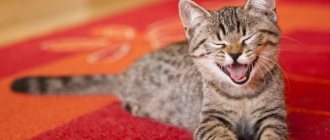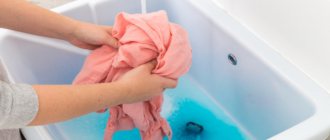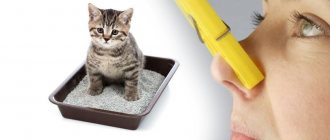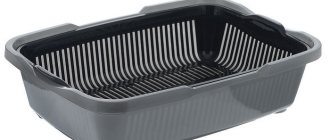A fluffy, purring little ball brings happiness and a lot of positivity to the house.
But a cat is not only a pleasure, but also a care, ignoring which can cause a very unpleasant smell to appear in the apartment. How to remove cat smell in an apartment, what to do if a cat has marked in the house? Proven methods, recommendations and advice from experienced cat lovers will help you solve this rather complex problem and return clean air to your home.
Preparing to Remove Cat Odor in the House
In order for the cat smell to disappear from the apartment without leaving a trace, you need to correctly approach the process of removing “traces” of your pet.
To begin with, the puddle is covered with paper napkins (as they are absorbed, they are collected in a plastic bag). Alternatively, you can use cat litter instead of paper.
The purpose of such actions is to collect urine as quickly as possible, without waiting for it to be absorbed or smeared on the surface.
It is strictly unacceptable:
- cover up the cat’s “traces”;
- rub the surface with a brush or sponge;
- rub the urine on the floor with a wet rag.
Such manipulations will lead to an even greater spread of odor and absorption of urine.
Dry mustard
Even the simplest mustard powder can be used to remove cat urine.
- In order to remove stains and odor, you need to dilute the mustard powder with water to a paste consistency.
- Then this mass is applied directly to the desired place and allowed to sit for a while so that it dries a little.
- Then, using a wet rag, the mush is collected, and finally the area is wiped dry.
- Remaining mustard particles can be collected with a vacuum cleaner.
How to remove using folk remedies?
There are a sufficient number of ways to get rid of the unpleasant smell of cat urine in an apartment without special material costs.
Lemon acid
Treating urine stains with citric acid will not only get rid of the unpleasant odor, but also prevent the animal from trying to urinate in that area again.
Algorithm of actions:
- Dissolve 1 tsp in 100 ml of warm water. citric acid.
- Using a spray bottle, spray the prepared product onto the urine stain.
- After five minutes, the liquid is collected with paper napkins.
Before use, the citric acid solution is tested on an inconspicuous area (there is a high risk of surface discoloration).
Iodine
An iodine solution can remove urine stains (and with them an unpleasant odor) from dark wooden surfaces.
The steps are simple: 15 drops of iodine are dissolved in a liter of warm water , after which the “traces” of the animal are treated with the resulting composition. Iodine should not be used on light-colored fabrics or carpets.
Ammonia
Ammonia will help remove odors from fabrics. It is enough to apply the undiluted product liberally to the stain, leave it for a few minutes, and then rinse thoroughly under warm running water.
The smell of ammonia attracts animals, so treatment with ammonia is carried out only on those things that can be hidden from a pet.
Baking soda
Baking soda can be used to remove cat odor from soft upholstery of sofas and armchairs, and fleecy surfaces of carpets.
Algorithm of actions:
- soda powder is diluted with water to a thick paste;
- the resulting paste is applied to the urine stain and left until completely dry;
- Use a vacuum cleaner or soft sponge to remove the crust of soda paste.
By washing off dried baking soda with a sponge dipped in soap suds, the process of removing cat odors from the soft upholstery of sofas will speed up significantly.
Glycerol
Glycerin can remove cat “marks” from leather and fabric products, carpet or linoleum. It is enough to wipe the urine stain with a cotton swab soaked in glycerin and leave it until completely dry.
Glycerin is only effective for removing fresh cat marks . For stubborn, old stains, this product is useless.
Table vinegar
A universal assistant in the fight against unpleasant odors in the house is table vinegar. To remove “traces” of a cat, vinegar is diluted with water (ratio 1:3), and then sprayed through a spray bottle onto the stain.
Traces of urine and vinegar are blotted with paper towels, and then the surface is wiped with a damp sponge.
Treatment with vinegar will not only help get rid of the pungent odor of cat waste, but will also discourage your pet from pooping in the wrong place.
Laundry soap and lemon
Regular laundry soap and lemon will help
neutralize the unpleasant smell of cat urine .
It's simple: treat the stain with laundry soap, then rub it with a slice of lemon.
Lemon or orange peels will scare the animal away from further excrement on the previously treated surface.
How to remove with special compounds?
When cleaning using improvised means does not lead to the desired result, and you need to remove the unpleasant smell of cat urine as quickly as possible (there is no time to re-use traditional methods), professional means will come to the rescue . TOP 3 proven, effective compositions:
Urine Destroyer
A product for removing stubborn stains and neutralizing urine odor is an effective product designed specifically for quickly solving the problem of cat “marks” in the house. Quickly neutralizes rather than masks the “traces” of the animal.
Ideal for all types of surfaces . Safe for use in children's rooms. The average cost is 880 rubles. (750 ml bottle).
Hartz Nodor Litter Spray
A scented product that eliminates the odors of cat waste. A distinctive feature is the ability to encapsulate odor molecules upon contact with urine. The product is absolutely safe for use in residential areas.
Non-toxic, does not cause allergies . The average cost is 550 rubles. (500 ml bottle).
Laina MS Spray
A product from a domestic manufacturer, effective in combating odors and marks of pets in the apartment. Suitable for all types of surfaces. Safe for animals . After use it leaves a pleasant aroma of lavender or fir. The average cost is 360 rubles. (750 ml bottle).
Before using any product, you must carefully study the instructions for use. Do not exceed the time of exposure of the product to the corroded surface, use the product in a larger volume than indicated by the manufacturer.
What harm can it cause
Regular cleaning of the apartment, bathroom and furniture is an important condition for human health. It is especially important to pay more attention to hygiene if there are animals or small children in the house. Untimely removal of feces can lead to a deterioration in the general condition of household members, the spread of bacteria, infection with helminths and infections.
Hydrogen sulfide
One of the dangerous substances released by decomposing feces is hydrogen sulfide. It is a gas that has no color but has a disgusting, pungent odor of a rotten egg. Hydrogen sulfide is poisonous and has a toxic effect on humans and animals. At low concentrations, the gas has no significant harmful effect. If the smell is strong, a person's respiratory receptors are blocked and he stops feeling the stench. The process of intoxication begins, causing dizziness, nausea, loss of consciousness, and headaches. Hydrogen sulfide poisoning often leads to the development of chronic diseases of the respiratory tract and skin.
Ammonia and carbon dioxide
Ammonia and carbon dioxide are other derivatives of fecal fermentation. Gases in high concentrations are dangerous to humans. The mucous membranes of the eyes and respiratory tract are the first to be affected. Ammonia can cause severe burns if it comes into contact with skin. Inhaling carbon dioxide causes headaches, shortness of breath, and nausea.
Sometimes exposure to substances in higher concentrations forces a person to see a doctor.
Bacteria
The feces of warm-blooded animals and humans are a natural environment for the development of Escherichia coli bacteria. In addition, most domestic animals suffer from the presence of worms, many of which are parasitic in humans. Therefore, any contact with feces or incomplete removal can cause infection and the development of diseases of the digestive system.
See also
TOP 10 means and methods on how to get rid of and remove the smell of rubber
What to do for prevention?
It is possible to prevent the appearance of an unpleasant cat odor in the apartment if you adhere to certain rules:
- We place the tray only in secluded places. The cat always looks for corners hidden from prying eyes for the toilet.
- We treat the sites of potential “acts of revenge” with special products - cat bleaches. Particular attention should be paid to places where shoes are stored, the rug in front of the bed, and in the bathroom.
- Decorate flower pots with orange peels or pine cones. Cats love to make toilets in flowerpots; pine cones and oranges discourage the pet from marking its territory in this way.
- We change cat litter regularly. The domestic cat is an extremely clean animal that will never defecate in a dirty litter box.
A cat is an animal that does not tolerate violence. In response to beatings and humiliation, the cat will take revenge (mark its territory).
Adviсe
Observations and recommendations from experienced veterinarians will help in the difficult fight against unpleasant cat odors in the apartment:
An ultraviolet lamp will help to accurately determine the place where the cat left traces of urine (in a situation where the discharge has already been absorbed). Under its rays, the cat’s “footprints” begin to glow with white light.- It is not recommended to use coffee squeezes, pine needle or citrus aroma oils to eliminate cat odor in the house.
The result of applying natural fragrances to the scene of a cat’s “crime” is a significantly increased unpleasant odor. - You should not mask your cat's smell with perfume or eau de toilette. Mixed with the molecules of animal secretions, the aroma of perfume will turn into a pungent, suffocating odor.
- A good eliminater of cat odors is frost. It is enough to leave the shoes or clothes marked by your pet in the cold overnight (or place them in the freezer) and there will be no trace of the unpleasant odor.
What to do if the cat has marked in the house? If your cat is constantly marking its territory, and no preventive measures help get rid of the problem, you need to show it to the veterinarian.
Perhaps there are kidney or urinary tract diseases, which can be cured and you can forget about the problem of the unpleasant smell of cat marks forever.
This article will tell you how to remove the smell of cat urine from a carpet, and this article will tell you how to remove it from upholstered furniture.
You will find a lot of useful and important information about removing various unpleasant odors from objects and surfaces in this section.
Why is the smell of cat urine so persistent?
The amazing persistence of cat urine is due to the need to mark the controlled territory and is determined by the chemical composition of urine, which includes:
- water (95%);
- hormones;
- bacteria;
- amino acids (felinin);
- creatinine;
- sodium and potassium salts;
- urobilin and bilirubin (yellow-colored components);
- urea;
- uric (uric) acid and urates (salts).
Cat urine begins to decompose almost immediately
Once on any surface, urine begins to decompose almost immediately . Under the influence of bacteria that secrete a specific hydrolytic enzyme, urease, urea is broken down into carbon dioxide (carbon dioxide) and ammonia. Cat pheromones (amino acids), when decomposed, are transformed into mercaptan (thiol) - a volatile sulfur compound that has a pungent and extremely unpleasant odor.
When removing odor and, accordingly, stains from cat urine, three components present the greatest difficulty:
- its sticky part (urea);
- coloring pigments;
- uric acid.
It is very difficult to remove stains from carpet and remove the smell of cat urine.
The first two components are highly soluble in water or alcohol-containing liquids. Uric acid, when exposed to air, quickly crystallizes. This substance is poorly soluble in water, so it is impossible to remove it with conventional detergents. The settled crystals are impregnated with thiol and ammonia, creating a unique and long-lasting cat amber.











